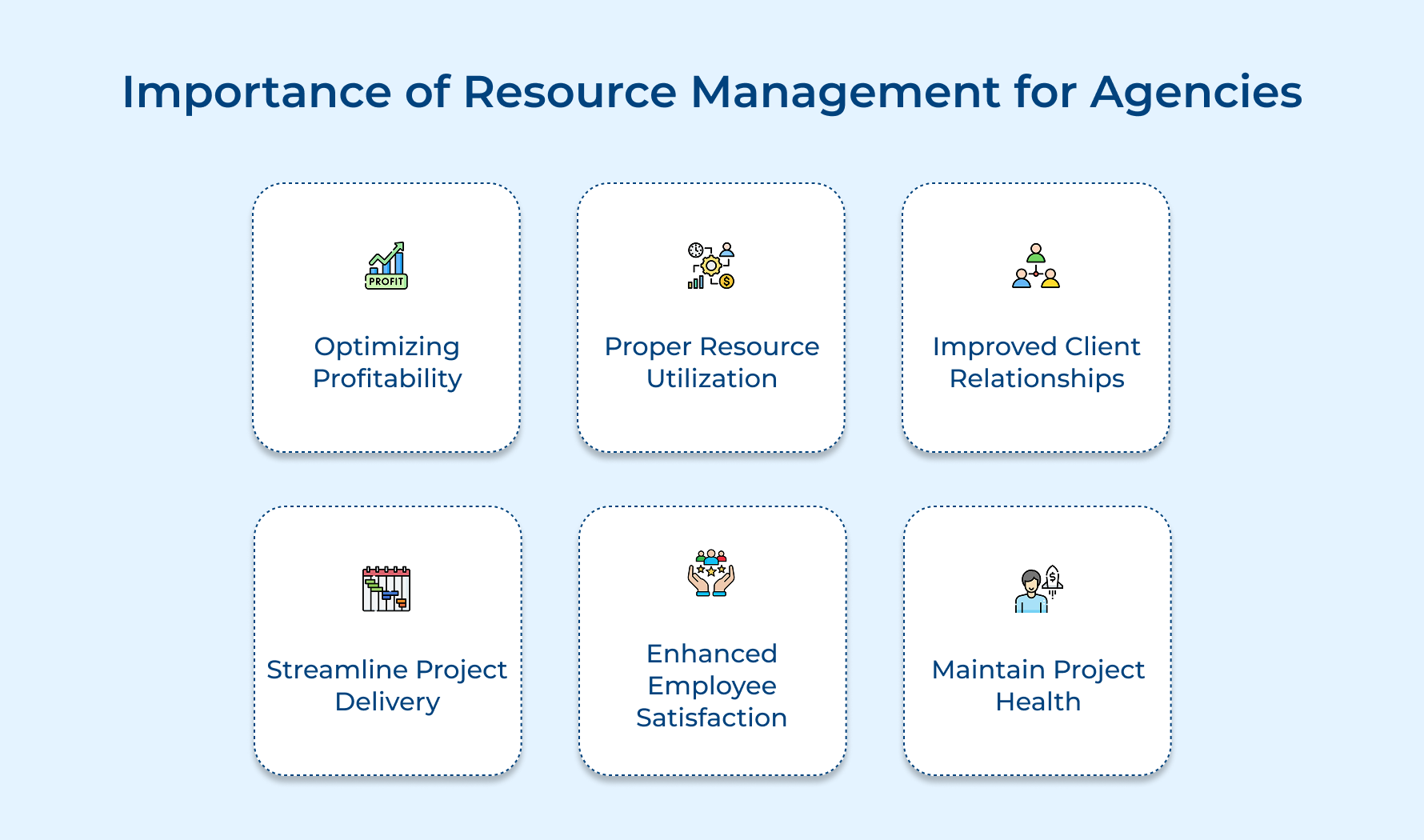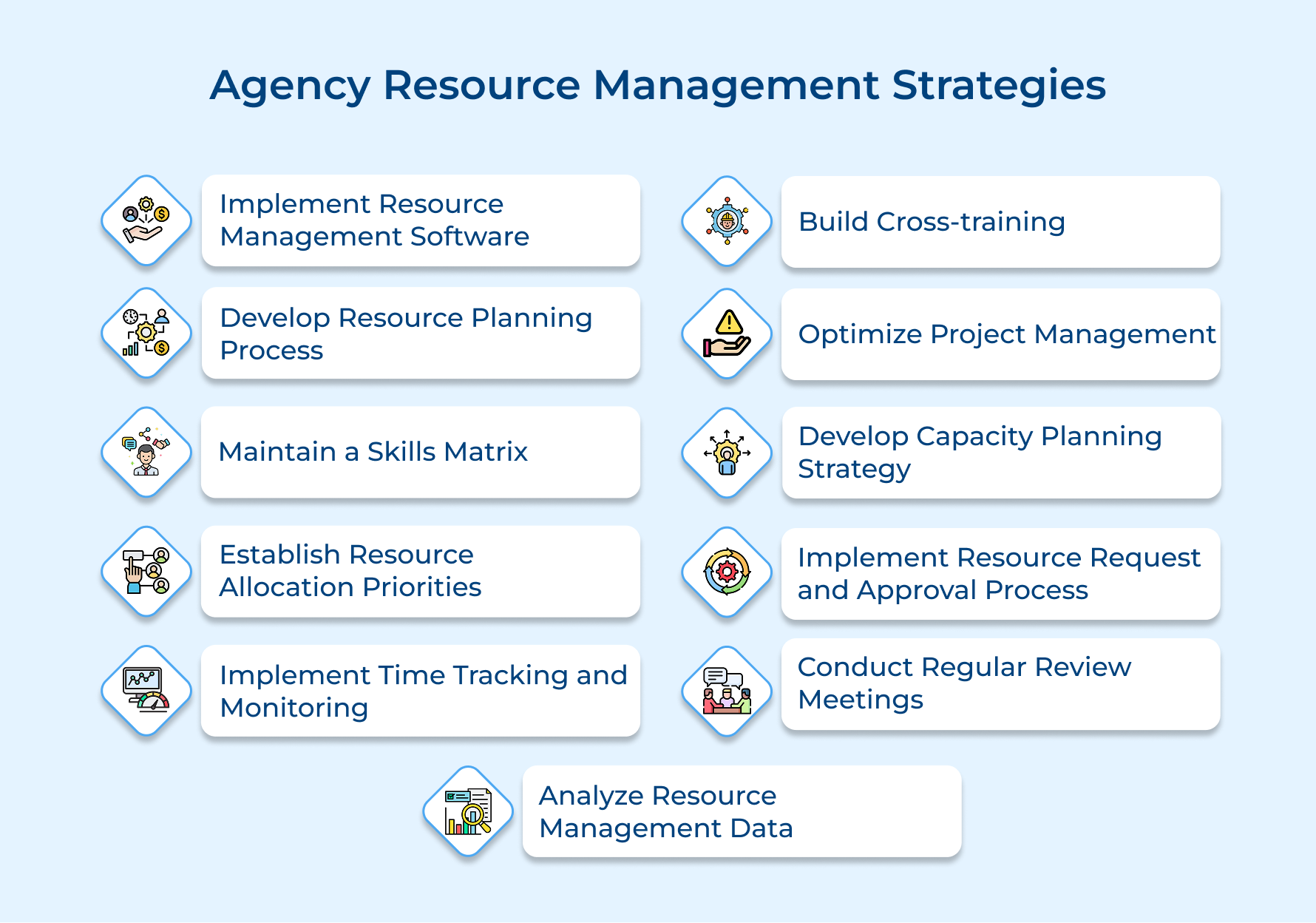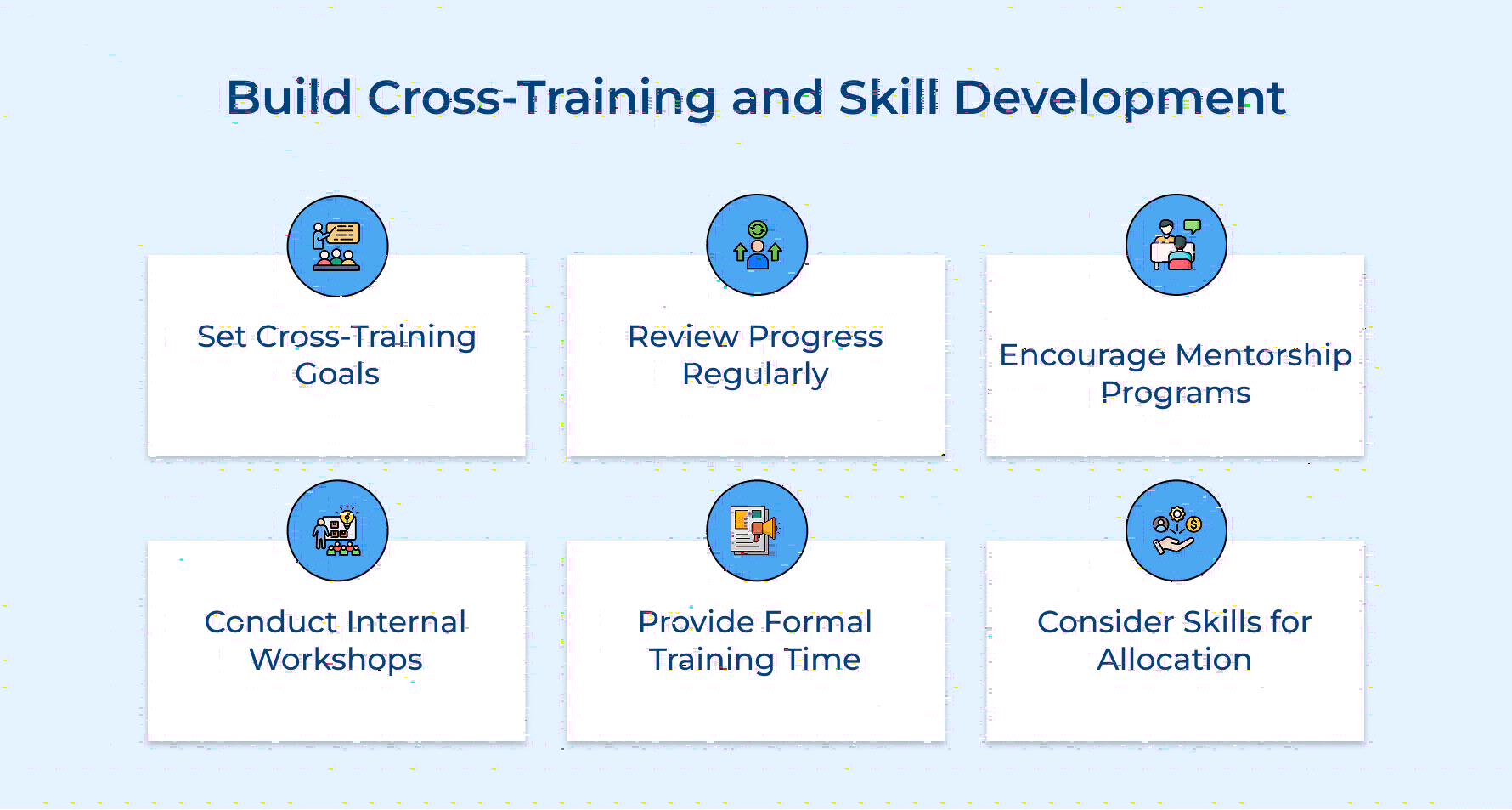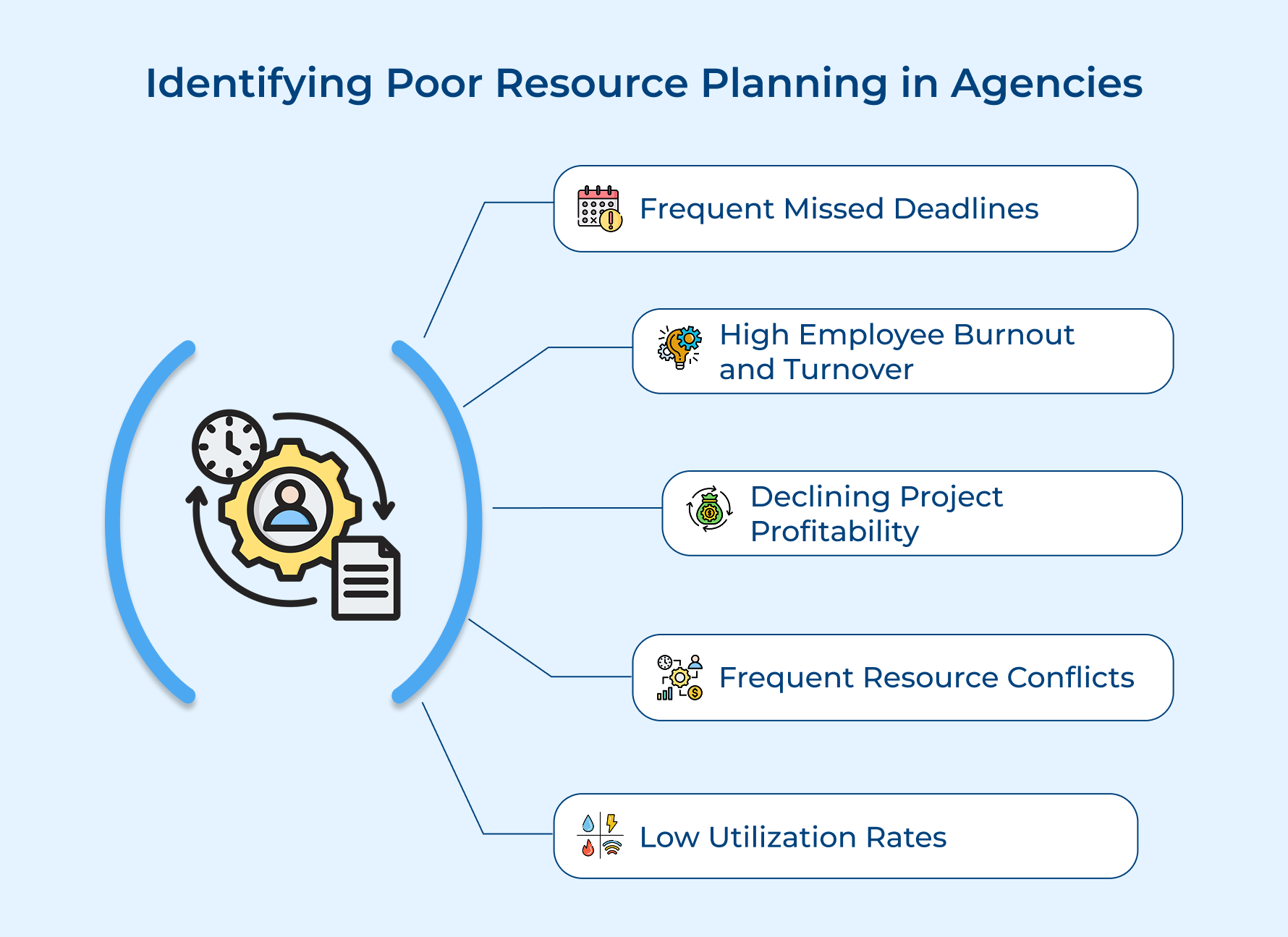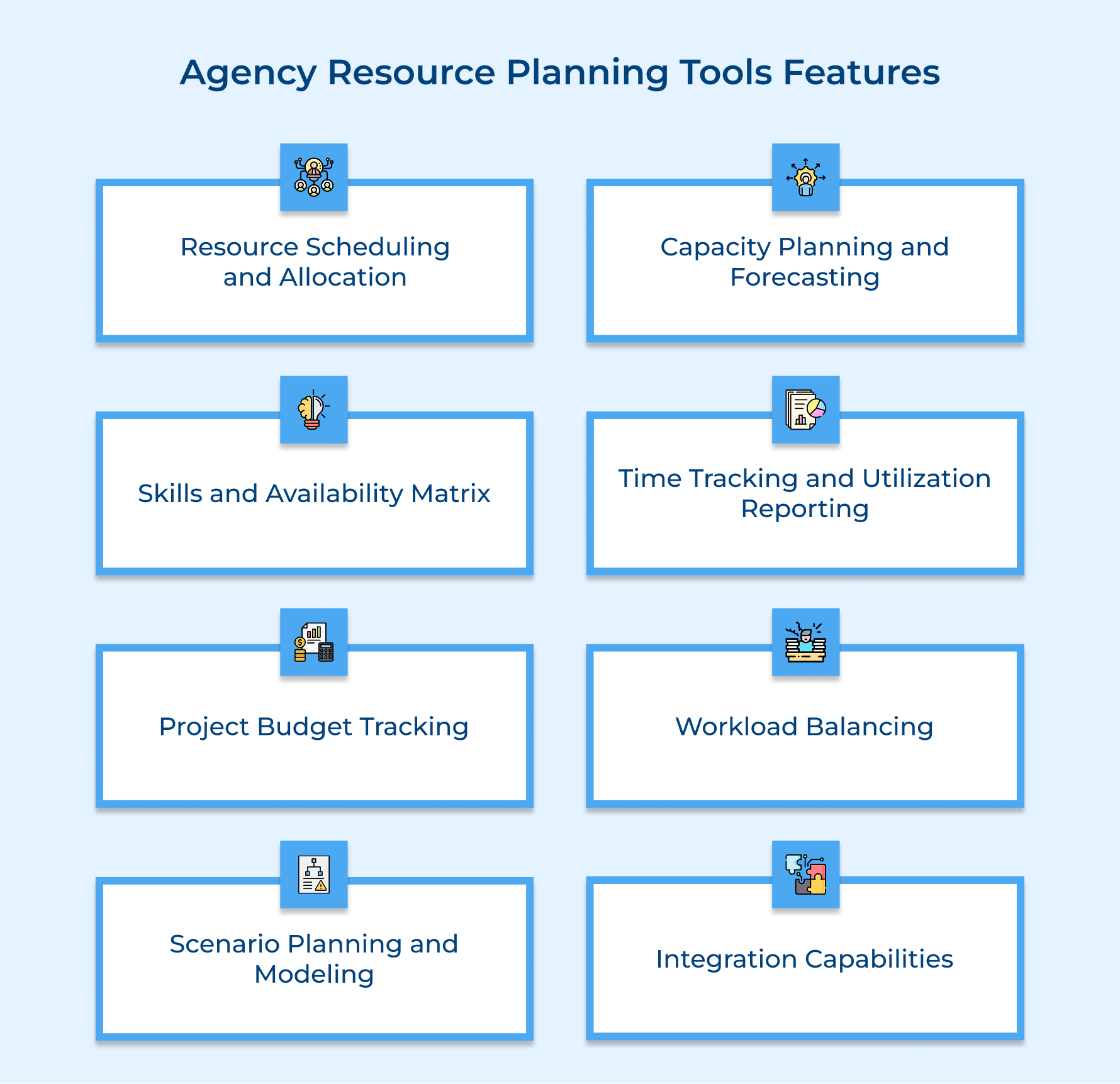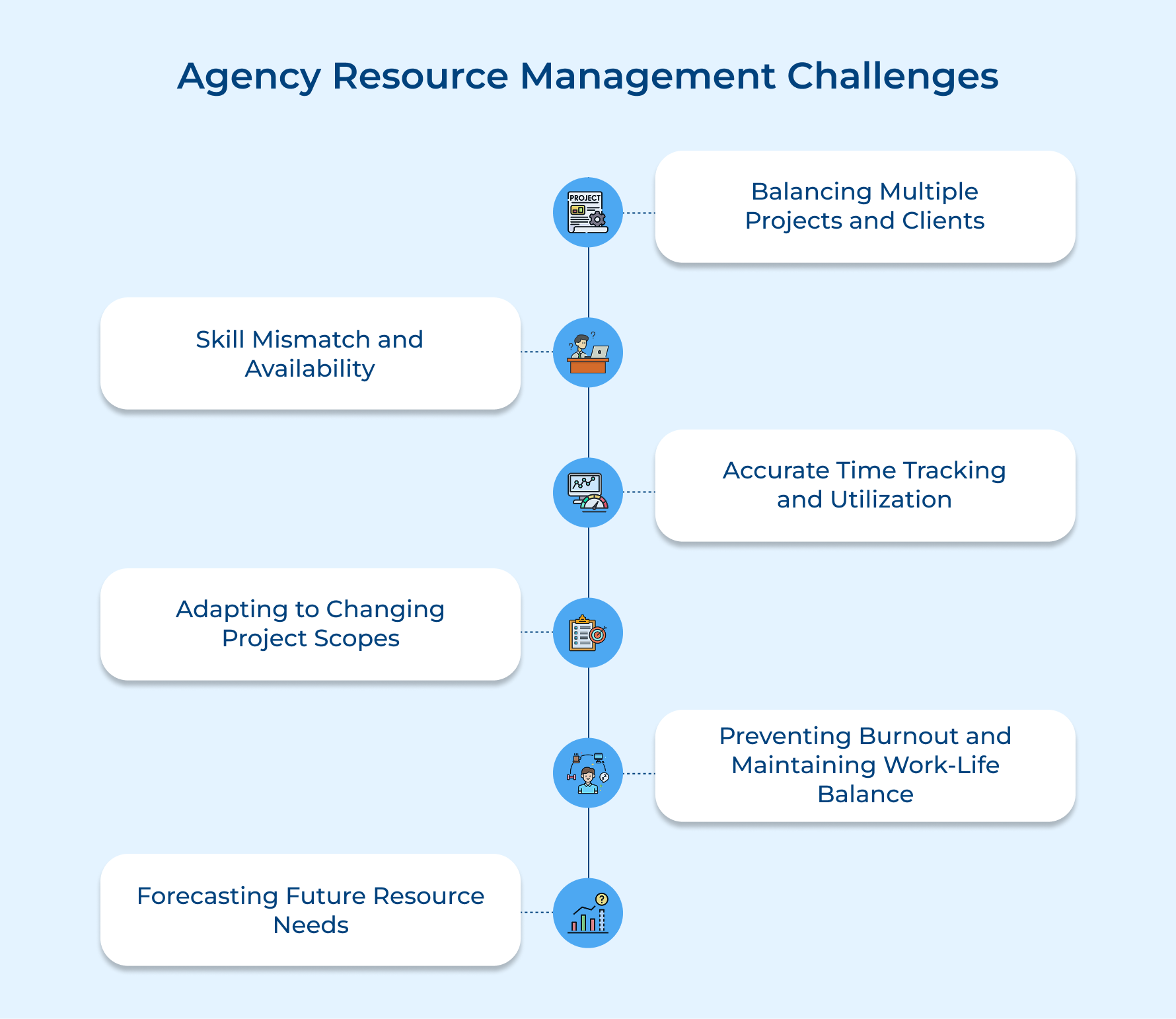Agency Resource Management Guide: Benefits & Best Practices
- What is Agency Resource Management?
- Why is Resource Management Important for Agencies?
- 11 Strategies for Effective Agency Resource Management
- How Do You Identify Poor Resource Planning in Agencies?
- Key Features of an Agency Resource Planning & Management Tool
- Challenges in Agency Resource Management (and Solutions)
- Getting Started with Agency Resource Management
- FAQs about Agency Resource Planning

Key Highlights
Many professional service businesses or agencies struggle to allocate their most valuable asset – their people – efficiently with multiple projects, diverse client demands, and constantly shifting market dynamics.
Lack of proper resource planning and management can be the cause. However, Deltek’s report mentions how 49% of the agency leaders were prepared to allocate significant funds for hiring more talent in 2022. Has there been any changes ever since? If you want to improve your agency resource management, you’re at the right place!
Our comprehensive guide is designed to transform how you manage your agency’s resource planning & talent. It provides proven strategies to streamline your operations, and boost profitability, as well as performance optimization.
What is Agency Resource Management?
Agency Resource Management is the strategic process of planning, scheduling, and allocating an agency’s human/material resources across various projects. It involves optimizing the use of available talent, skills, time, and tools to ensure efficient project delivery while maintaining profitability along with employee satisfaction.
The discipline encompasses tracking resource utilization, forecasting future needs, and making data-driven decisions about resource allocation and capacity planning. The upside of agency resource management is that it ensures all projects are adequately staffed with the right mix of skills.
Though resource management helps agencies maintain profitability by optimizing billable hours, it also contributes to employee satisfaction with workload balance as well as skill development opportunities.
Key objectives:
- Maximize resource utilization: Ensure that all resources, particularly human talent, are used efficiently across projects to optimize productivity and profitability.
- Balance workloads: Distribute work evenly among team members to prevent burnout and maintain consistent quality of output.
- Forecast resource needs: Anticipate future resource requirements based on upcoming projects and agency growth plans to inform hiring as well as training decisions.
- Enhance project delivery: Align the right resources with the right projects at the right time to improve project outcomes and client satisfaction.
Why is Resource Management Important for Agencies?
Agencies find resource management to be crucial as it ensures projects are run smoothly without the team burning out. Let’s explore other reasons why.
1. Optimizing Profitability
Effective resource management maximizes agency profitability. By accurately allocating resources and tracking utilization rates, agencies ensure that billable hours are optimized across all projects. It prevents over-servicing clients and helps maintain healthy profit margins.
Resource management tools provide insights into the most profitable projects and clients, allowing agencies to make informed decisions about which opportunities to pursue as well as how to price their services.
2. Proper Resource Utilization
The strategy is all about assigning the right people with the right skills to the right projects at the right time. The optimal allocation prevents bottlenecks, reduces idle time, and maximizes productivity.
The management also helps agencies identify skill gaps and make informed decisions about hiring or training needs. Proper utilization leads to more efficient operations as well as the ability to take on more projects without overextending the team.
3. Improved Client Relationships
When resources are managed effectively, agencies can provide more accurate timelines and deliver projects more consistently. Reliability builds trust and improves client satisfaction.
Agencies here get to quickly respond to changing client needs by reallocating resources as necessary. The ability to provide skilled teams for each project enhances the quality of work and strengthens client relationships.
4. Streamline Project Delivery
Resource management tools provide a clear overview of all ongoing projects and available resources. The visibility allows project managers to plan more effectively, anticipate potential conflicts, and resolve issues before they impact project timelines.
Ensuring that projects are adequately staffed throughout their lifecycle helps agencies deliver projects on time and within budget.
5. Enhanced Employee Satisfaction
Balanced workloads are key to preventing burnout and maintaining high employee morale. Effective resource management ensures that work is distributed evenly among team members, preventing overwork and stress.
Agencies can also leverage better planning of time off and provide opportunities for skill development by matching employees with projects that challenge/interest them. It leads to higher job satisfaction, improved retention rates, and a more positive work environment.
6. Maintain Project Health
Resource management provides early warning signs for projects that may be at risk. By tracking resource allocation and utilization in real time, agencies can quickly identify projects that are consuming more resources than planned.
The process allows for timely interventions, whether it’s reallocating resources, adjusting project scopes, or having important conversations with clients. Maintaining project health through effective resource management helps agencies avoid cost overruns and ensure successful project outcomes.
11 Strategies for Effective Agency Resource Management
Wish to run a successful agency without overwhelming your team or missing deadlines? Here are some effective strategies to help you optimize your resources and keep projects on track.
1. Implement a Robust Resource Management Software
Implementing robust resource management software offers a centralized platform for tracking, allocating, and optimizing resources across multiple projects as well as clients. It eliminates manual errors, reduces administrative overhead, and offers real-time visibility into resource utilization. This tool is crucial for making informed decisions about resource allocation, capacity planning, and project scheduling.
The software helps you create a comprehensive view of all agency resources, including their skills, availability, and current assignments. Leverage its features to allocate resources to projects, track utilization rates, and forecast future resource needs. Use the data & insights provided by the software to identify potential resource conflicts, and optimize workloads, while also making strategic decisions about hiring or training.
Actionable tips:
- Involve key stakeholders in the software selection process to ensure it meets the specific needs of your agency, and provide thorough training to all users.
- Integrate the resource management software with other agency tools (e.g., project management, time tracking) to create a seamless workflow and ensure data consistency.
2. Develop a Comprehensive Resource Planning Process
A comprehensive resource planning process is necessary because it provides a structured approach to aligning resources with project demands and agency goals. It helps prevent resource conflicts, ensures optimal utilization of talent, and supports more accurate project estimates/timelines.
Implement a regular resource planning cycle that aligns with your agency’s project lifecycle and business rhythm. Use this process to forecast resource needs based on confirmed and potential projects, and identify capacity gaps or surpluses, while also making informed decisions about resource allocation. Regularly adjust the plan to account for changes in project scopes, timelines, or agency priorities.
Actionable tips:
- Create a resource planning template that includes key information such as project timelines, required skills, and estimated hours.
- Hold regular resource planning meetings with project managers and department heads to ensure alignment as well as address potential conflicts proactively.
3. Create and Maintain a Skills Matrix
A skills matrix provides a clear overview of the capabilities and expertise within your agency. It helps in identifying the right resources for specific project needs, highlights skill gaps, and supports strategic decisions about training/hiring. A well-maintained skills matrix ensures that your agency can effectively meet client demands and adapt to changing market needs.
Use the skills matrix to match team members with appropriate projects based on their expertise. Leverage it during resource allocation to ensure a balanced mix of skills on each project team. The matrix helps you to identify areas where additional training or hiring may be necessary.
Actionable tips:
- Involve team members in creating and updating their skill profiles to ensure accuracy as well as encourage ownership of professional development.
- Use a digital platform or spreadsheet to create the skills matrix, ensuring it’s easily accessible to relevant stakeholders.
4. Establish Clear Resource Allocation Priorities
Your agency’s most valuable resources are assigned to the most critical or profitable projects when you establish clear priorities. It helps in managing competing demands for resources, reduces conflicts, and aligns resource allocation with strategic business goals. Clear priorities also help in making quick decisions when resource conflicts arise.
Develop a set of criteria for prioritizing projects and resource requests. These might include factors such as project profitability, strategic importance, client relationship value, or deadline urgency. Apply this prioritization framework when making resource allocation decisions or resolving conflicts between competing resource needs.
Actionable tips:
- Involve key stakeholders, including senior management and project leads, in developing the prioritization criteria to ensure buy-in as well as alignment with agency goals.
- Regularly adjust the prioritization criteria to reflect changes in agency strategy or market conditions, ensuring they remain relevant.
5. Implement Time Tracking and Utilization Monitoring
When you understand how accurate data on resources helps understand profitability, identifying inefficiencies and making informed decisions will also follow the natural course. Thus, implementing time tracking and utilization monition becomes essential.
Time-tracking tools help you capture detailed information about how team members are spending their time. Analyze this data to calculate utilization rates, identify over- or under-utilized resources, and learn the true cost of projects. Use utilization reports to inform resource allocation decisions, adjust workloads, as well as identify areas where processes can be optimized to improve efficiency.
Actionable tips:
- Choose a user-friendly time-tracking tool and integrate it with your project management software to minimize disruption to workflow.
- Establish clear guidelines for time tracking, including what activities should be logged and how detailed entries should be, to ensure consistency of data.
6. Build Cross-training and Skill Development
Building cross-training and skill development increases the resilience of your agency’s workforce. It helps in addressing skill gaps, reduces dependency on specific individuals, and allows for more agile resource allocation. Cross-training also contributes to employee satisfaction as well as retention by providing opportunities for professional growth and varied work experiences.
Implement a structured cross-training program where team members can learn skills from different disciplines or departments. Encourage mentorship relationships within the agency. Allocate time and resources for formal training as well as skill development activities. Consider cross-trained individuals when allocating resources to projects that require diverse skill sets.
Actionable tips:
- Create individual development plans for team members that include cross-training goals, and regularly review progress as part of performance evaluations.
- Implement a “skill-sharing” initiative where team members with specific expertise conduct internal workshops or training sessions for their colleagues.
7. Optimize Project Scheduling and Timeline Management
Optimizing project scheduling prevents resource conflicts, reduces idle time, and meets project deadlines. Effective scheduling also contributes to balanced workloads, preventing burnout and maintaining work quality. It’s crucial for managing client expectations and maintaining the agency’s reputation for reliability.
Project management software helps you to create detailed schedules that account for resource availability and dependencies. Implement techniques like resource leveling to balance workloads across the team. Use scheduling data to identify potential bottlenecks or periods of high demand, and plan resource allocation accordingly.
Actionable tips:
- Implement a standard project scheduling template that includes key milestones, resource requirements, and buffer time for unexpected delays or changes.
- Conduct regular schedule reviews with project teams to ensure timelines remain realistic and to address any potential resource conflicts proactively.
8. Develop a Capacity Planning Strategy
Capacity planning strategy is all about enabling agencies to anticipate and prepare for future resource needs. It enables proactive decision-making about hiring, training, or outsourcing to meet upcoming project demands. Effective capacity planning prevents resource shortages, reduces last-minute scrambling for talent, and supports sustainable agency growth.
A regular capacity planning process should ideally look at both short-term and long-term resource needs. Use historical data and future projections to forecast resource requirements. Compare these forecasts with current and planned resource availability to identify potential gaps/surpluses. The information can then be used for strategic decision-making for hiring, training, or adjusting business development efforts.
Actionable tips:
- Create a capacity planning dashboard that visualizes current resource utilization, upcoming project demands, and projected capacity to facilitate quick decision-making.
- Involve both project managers and business development teams in the capacity planning process to ensure alignment between sales efforts as well as resource availability.
9. Implement a Resource Request and Approval Process
When you require structure and transparency in resource allocation decisions, the resource request/approval process comes in handy. It helps in managing competing demands for resources, ensures that allocations align with agency priorities, and prevents unauthorized use of resources. This process is crucial for maintaining control over resource utilization and avoiding conflicts between projects or departments.
Establish a standardized process for requesting resources, including required information such as project details, required skills, and duration. Implement an approval workflow that involves relevant stakeholders (e.g., resource managers, and project managers). Use this process to evaluate requests against resource availability and agency priorities.
Actionable tips:
- Create a simple, user-friendly form or digital interface for submitting resource requests to encourage compliance with the process and ensure all necessary information is provided.
- Establish clear criteria for resource request approval, and communicate these criteria to all team members to set expectations as well as reduce unnecessary requests.
10. Conduct Regular Resource Review Meetings
Regular resource review meetings are essential because they provide a forum for discussing resource-related issues, making allocation decisions, and adjusting strategies as needed. These meetings help in identifying/resolving resource conflicts and ensuring alignment between different projects as well as departments, all while maintaining visibility into overall resource utilization.
Schedule regular (e.g., weekly or bi-weekly) resource review meetings with key stakeholders such as project managers, resource managers, and team leads. Use these meetings to review current resource allocations, discuss upcoming needs, and address any issues or conflicts. Review resource utilization data and capacity forecasts. Make collective decisions about resource reallocation, and identify actions needed to address any resource gaps or inefficiencies.
Actionable tips:
- Prepare and distribute a standard agenda along with relevant resource reports before each meeting to ensure productive discussions as well as informed decision-making.
- Assign clear action items as well as responsibilities at the end of each meeting, and follow up on these in subsequent meetings to ensure continuous improvement.
11. Analyze and Act on Resource Management Data
Drive informed decision-making along with continuous improvement by analyzing and acting on resource management data. It helps in identifying trends, inefficiencies, and opportunities for optimization in resource utilization. Data-driven resource management supports strategic planning, enhances operational efficiency, and contributes to the agency’s overall performance.
Analytics tools help to identify patterns and insights, such as which types of projects or clients are most resource-intensive. Generate reports on key resource management metrics. Use these insights to inform decisions about resource allocation, hiring, training, and process improvements.
Actionable tips:
- Develop a set of key performance indicators (KPIs) for resource management, and create a dashboard to track these metrics over time, making it easy to spot trends as well as anomalies.
- Establish a regular cycle for in-depth data analysis and strategy review, ensuring that insights are consistently translated into actionable improvements in resource management practices.
How Do You Identify Poor Resource Planning in Agencies?
Spotting poor resource planning early can save your agency from a lot of headaches down the road. Let’s look at some telltale signs that your resource management might need a revamp.
1. Frequent Missed Deadlines
One of the most obvious signs of poor resource management is consistently missing project deadlines. This often occurs when resources are overallocated or improperly distributed across projects. If your agency regularly struggles to deliver work on time, it’s a clear indicator that resources are not being managed effectively. It leads to client dissatisfaction, rushed work, and increased stress for team members.
2. High Employee Burnout and Turnover
When resources are poorly managed, it often results in some team members being overworked while others may be underutilized. Consistently long working hours, frequent last-minute rushes, and a constant state of high stress are signs of poor resource allocation. It causes burnout, decreased job satisfaction, and ultimately, high employee turnover. If your agency is experiencing a higher-than-normal attrition rate, it may be time to reassess your resource management practices.
3. Declining Project Profitability
Poor resource management can significantly impact project profitability. If you notice that projects are consistently going over budget or requiring more hours than estimated, it could indicate inefficient use of resources. It might manifest as excessive overtime costs, the need to bring in expensive freelancers at the last minute, or simply more hours being spent on tasks than necessary due to poor planning or allocation.
4. Frequent Resource Conflicts
If your agency often finds itself in situations where multiple projects are competing for the same resources, leading to delays or rushed work, it’s a sign of poor resource management. It results in constant firefighting, where project managers are continually negotiating for resources or making last-minute schedule changes to accommodate conflicting demands.
5. Low Utilization Rates
While overallocation is a common problem, underutilization can be equally problematic. If your utilization rates are consistently low, it means you’re not efficiently using the resources at your disposal. It eats into agency profits and may indicate poor project planning or ineffective resource allocation strategies.
Key Features of an Agency Resource Planning & Management Tool
An agency resource planning tool can be a game-changer when it comes to keeping projects organized and teams on track. Let’s dive into the key features that make these tools essential.
1. Resource Scheduling and Allocation
The feature allows project managers to assign team members to specific projects and tasks based on their skills, availability, capacity, etc. It typically includes visual tools like Gantt charts or calendars for intuitive scheduling, ensuring optimal resource utilization and preventing overbooking.
2. Capacity Planning and Forecasting
The functionality provides insights into current as well as future resource capacity, allowing agencies to predict resource needs and identify potential shortages or surpluses. It enables proactive decision-making about hiring, training, or business development.
3. Skills and Availability Matrix
A comprehensive database that tracks team members’ skills, experience, certifications, and availability. The feature facilitates better matching of resources to project requirements and supports effective resource allocation as well as professional development planning.
4. Time Tracking and Utilization Reporting
Team members get to log time against projects/tasks and generate reports on resource utilization rates. It provides accurate data for client billing, helps identify inefficiencies, and supports data-driven decisions about resource allocation along with project profitability.
5. Project Budget Tracking
Integrates resource costs with project budgets to provide real-time financial insights. It helps maintain project profitability by allowing managers to monitor resource costs against budgets and make timely adjustments if projects are at risk of overrunning.
6. Workload Balancing
Visualizes individual and team workloads, highlighting over- or under-utilization of resources. It prevents burnout by ensuring equitable distribution of work, and improving employee satisfaction, while also maintaining consistent quality of output across projects.
7. Scenario Planning and Modeling
Managers model different resource allocation scenarios and their potential impacts. The tool supports strategic decision-making by enabling agencies to assess the resource implications of potential new projects or changes in existing projects before committing.
8. Integration Capabilities
The ability to integrate with other business tools such as project management software, financial systems, CRM, or HR platforms. It creates a seamless workflow, reduces data entry duplication, and provides a more comprehensive view of agency operations.
Challenges in Agency Resource Management (and Solutions)
Managing resources in an agency can be tricky, with challenges like overbooking or underutilizing your team. Here are some common hurdles and practical solutions to help you.
1. Balancing Multiple Projects and Clients
Challenge: Agencies often juggle multiple projects and clients simultaneously, making it difficult to allocate resources effectively without overcommitting or underutilizing team members.
Solution: Implement a centralized resource management system that provides a real-time overview of all projects and resource allocations. Use capacity planning tools to forecast resource needs and identify potential conflicts in advance. Establish clear prioritization criteria for projects to guide resource allocation decisions when conflicts arise.
2. Skill Mismatch and Availability
Challenge: Ensuring the right skills are available at the right time for each project can be challenging, especially when dealing with specialized or niche skills.
Solution: Create and maintain a comprehensive skills matrix for all team members. Implement a robust resource request process that matches project needs with available skills. Invest in cross-training programs to increase the versatility of your team. Consider building a network of reliable freelancers or contractors to fill skill gaps when needed.
3. Accurate Time Tracking and Utilization
Challenge: Getting team members to accurately track their time and maintaining optimal utilization rates can be difficult, leading to issues with project profitability as well as resource planning.
Solution: Choose user-friendly time-tracking tools and integrate them into daily workflows. Educate team members on the importance of accurate time tracking. Set clear utilization targets and regularly review performance. Use automation to remind team members to log their time and to flag unusual patterns or discrepancies.
4. Adapting to Changing Project Scopes
Challenge: Project scopes in agency work often change, requiring quick adjustments to resource allocations that can disrupt other projects or lead to overallocation.
Solution: Build buffer time into project schedules to accommodate changes. Implement a formal change request process that includes reassessing resource needs. Use Agile methodologies to break projects into smaller, manageable sprints, allowing for more flexibility in resource allocation.
5. Preventing Burnout and Maintaining Work-Life Balance
Challenge: The fast-paced nature of agency work can lead to employee burnout, especially when resources are stretched thin across multiple projects.
Solution: Monitor individual workloads closely and set maximum utilization thresholds. Facilitate time off and breaks between intense project phases. Implement policies that protect personal time, such as no-email hours or days. Regularly gather feedback from team members about their workload and stress levels.
6. Forecasting Future Resource Needs
Challenge: Accurately predicting future resource requirements to inform hiring decisions and business development efforts can be difficult, especially in a rapidly changing market.
Solution: Develop a structured capacity planning process that considers both confirmed projects and potential opportunities in the sales pipeline. Use historical data to identify patterns in resource demand. Involve both project managers and sales teams in resource forecasting discussions. Regularly adjust forecasts based on changing market conditions and agency goals.
Getting Started with Agency Resource Management
Resource planning management is crucial for agencies and professional services businesses due to the dynamic nature of their work. They often juggle multiple projects and clients simultaneously, making efficient resource allocation essential.
By implementing robust resource planning and management practices, agencies as well as professional services businesses can significantly improve their profitability along with operational efficiency. Optimized resource allocation leads to better utilization rates, reducing idle time and increasing billable hours. This, in turn, enhances project profitability. Client engagement benefits from consistent quality of work, on-time deliveries, and the ability to quickly respond to changing client needs.
Limit time — not creativity
Everything you need for customer support, marketing & sales.
Neeti Singh is a passionate content writer at Kooper, where he transforms complex concepts into clear, engaging and actionable content. With a keen eye for detail and a love for technology, Tushar Joshi crafts blog posts, guides and articles that help readers navigate the fast-evolving world of software solutions.
